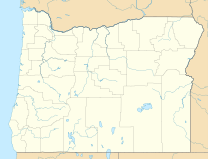Cape Meares National Wildlife Refuge
| Cape Meares National Wildlife Refuge | |
|---|---|
|
IUCN category IV (habitat/species management area)
|
|

Cape Meares as seen from nearby beach
|
|
| Location | Tillamook County, Oregon, USA |
| Nearest city | Cape Meares |
| Coordinates | 45°29′14″N 123°57′49″W / 45.4873248°N 123.9637426°WCoordinates: 45°29′14″N 123°57′49″W / 45.4873248°N 123.9637426°W |
| Area | 138.51 acres (56 ha) |
| Established | 1938 |
| Governing body | U.S. Fish and Wildlife Service |
| Website | Cape Meares NWR |
Cape Meares National Wildlife Refuge is a National Wildlife Refuge of the Oregon Coast. It is one of six National Wildlife Refuges in the Oregon Coast National Wildlife Refuge Complex. Located on Cape Meares, the refuge was established in 1938 to protect a remnant of coastal old-growth forest and the surrounding habitat used by breeding seabirds. The area provides a home for a threatened bird species, the marbled murrelets. Peregrine falcons, once at the brink of extinction, have nested here since 1987. The refuge, with the exception of the Oregon Coast Trail, was designated a Research Natural Area in 1987.
The Cape Meares Light, which marked the cape at night from 1890 until 1963, is now open to the public. Three Arch Rocks National Wildlife Refuge and Oregon Islands National Wildlife Refuge are easily seen from the cape. It is the only point in the United States from which three refuges can be seen at the same time.
The Oregon Coast Trail passes through the center of this headland and interpretive displays along the trail describe the varied wildlife. From this trail, it is possible to see migrating gray whales, three species of scoters, western grebes, and common loons. A wildlife viewing deck, part of the Cape Meares State Scenic Viewpoint, provides views of the refuge's sea cliffs and inshore islands. In season, visitors can see the aerie of a nesting peregrine falcon pair. Each spring thousands of seabirds return to nest on the cliffs. Species that can be seen are brants, pelagic cormorants, common murres, tufted puffins, pigeon guillemots, western gulls, and black oystercatchers. This state park has 3 miles (4.8 km) of hiking trails and a 1-mile (1.6 km) walking trail through the forest of sitka spruce and western hemlock.
...
Wikipedia

